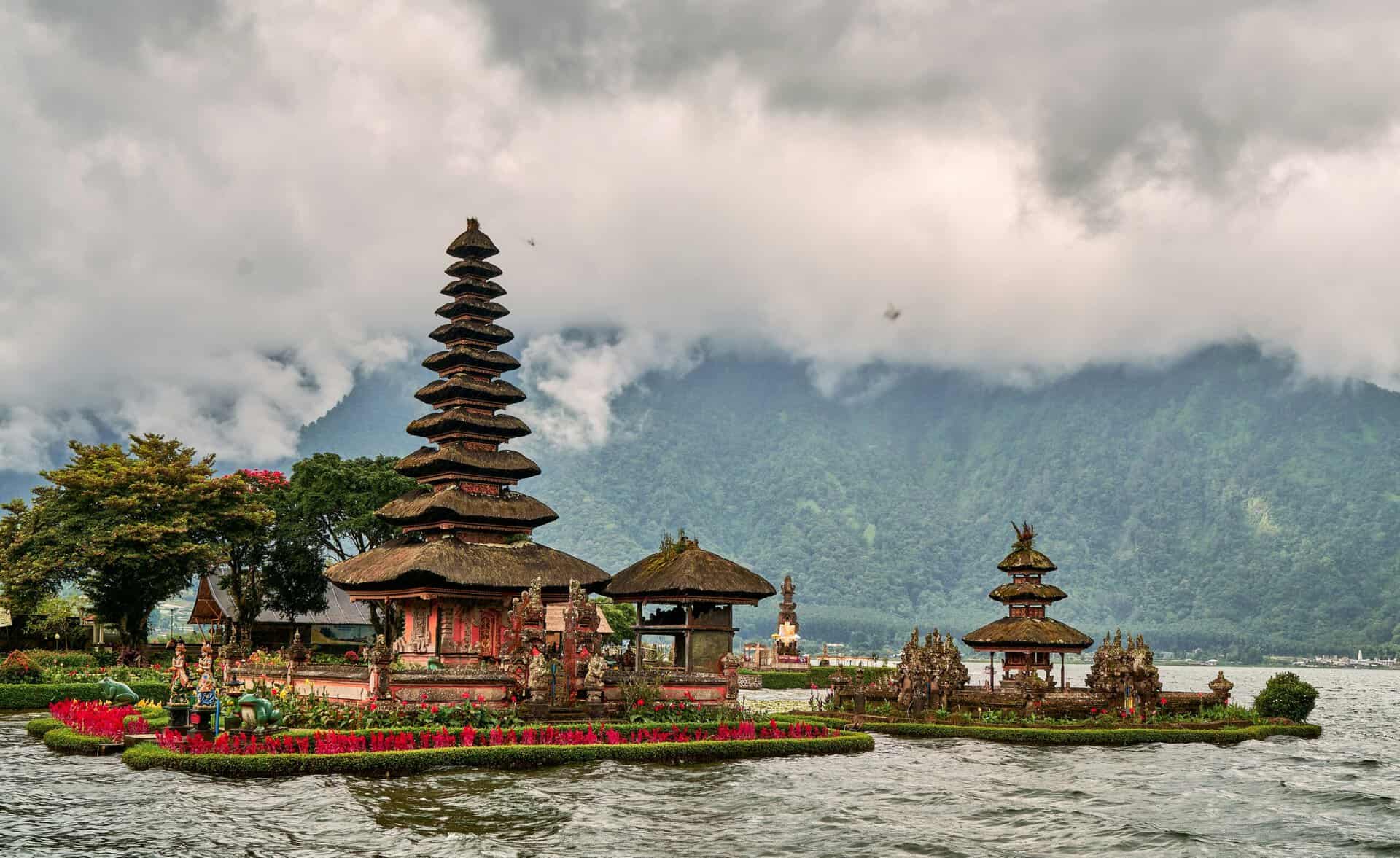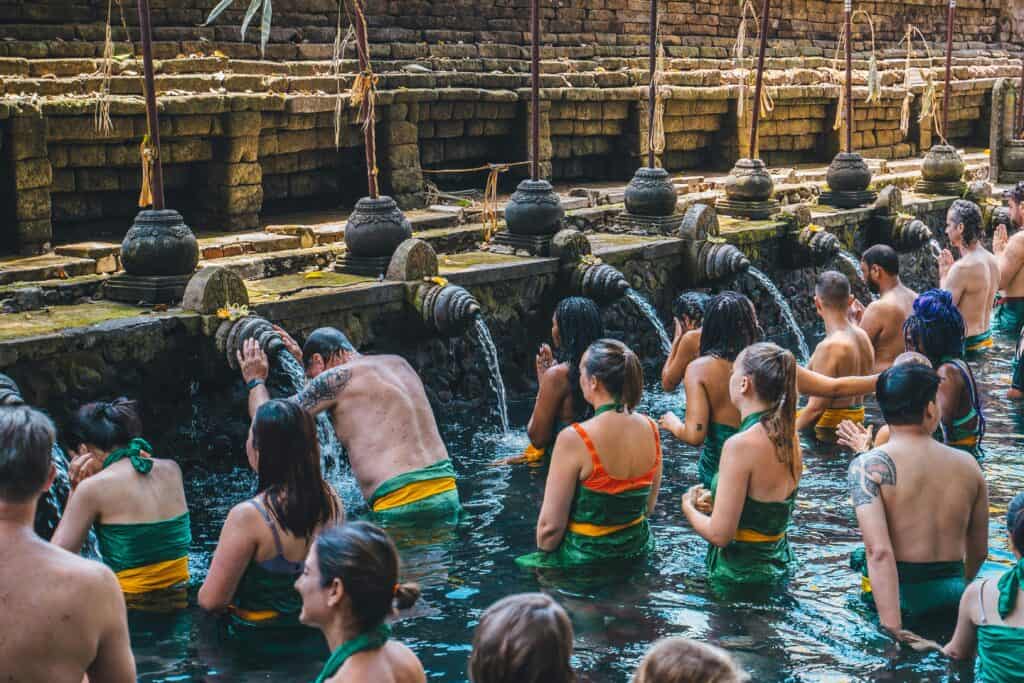Bali’s culture is a huge part of its appeal. Its rich traditions, lively ceremonies, and beautiful architecture make it a popular destination. This guide will introduce you to Bali’s famous temples, perfect for those curious about Balinese life and beliefs. Temples are essential in Balinese Hinduism, serving as places of worship, cultural landmarks, and community hubs. They’re not just impressive buildings; they carry deep spiritual meaning for the Balinese people.
Key Takeaways
- Bali has a rich temple culture that is an integral part of the island’s spiritual and cultural identity.
- Pura Tirta Empul in Ubud is a sacred water temple where visitors can participate in a traditional purification ritual.
- Tanah Lot Temple in Tabanan is a stunning sea temple that offers breathtaking views of the ocean and surrounding landscape.
- Besakih Temple in Karangasem is known as Bali’s Mother Temple and is the largest and most important temple on the island.
- Uluwatu Temple in Jimbaran is a cliffside temple that offers spectacular views of the Indian Ocean and is famous for its traditional Kecak dance performances.
Pura Tirta Empul
Located in the village of Tampaksiring, Pura Tirta Empul is one of Bali’s most important temples. The temple is built around a sacred spring water source, which is believed to have healing properties. The water is used for purification rituals and ceremonies, where devotees immerse themselves in the holy water to cleanse their body and soul.
Tirta Empul was founded in 926 A.D and is still being actively used to this day. The temple’s history dates back to the 10th century during the Warmadewa dynasty. It was built to honor the god Indra and his victory over a demon king. Today, Pura Tirta Empul attracts both locals and tourists who come to witness or participate in the purification rituals. The temple’s serene atmosphere and beautiful surroundings make it a must-visit destination for those seeking spiritual enlightenment.
Although it is a sacred place of worship to the locals, tourists from all over the world are welcome to experience the beauty and participate in the purification rituals. In 2017, the former US President Barack Obama, Michelle Obama, and daughters Malia and Natasha, made Tirta Empul one of their selected sites to visit and experience.
To enter the Tirta Empul temple, visitors are required to pay an entrance fee. Additionally, it is advisable to wear a sarong, which along with a scarf, is available at the entry fee ticket counter. The ticket prices are as follows: IDR 50,000 per person for adults, IDR 25,000 per person for children aged 5-11 years old, IDR 5,000 per car for car parking, and IDR 2,000 per scooter for motorcycle parking.
Tanah Lot Temple
Perched on a rocky outcrop along Bali’s southwestern coast, Tanah Lot Temple is one of the island’s most iconic landmarks. This sea temple is dedicated to the sea gods and is believed to guard Bali from evil spirits. The temple’s unique location makes it a popular spot for tourists, especially during sunset when the temple is silhouetted against the vibrant colors of the sky.

According to local legends, Tanah Lot Temple was created by a Hindu priest named Dang Hyang Nirartha during his travels through Bali. He saw the beauty of the location and decided to build a temple to honor the sea gods. The temple is said to be guarded by venomous sea snakes, which are believed to be the protectors of the temple.
Another saying is there’s a curse in Tanah Lot Temple then its served as the inspiration for the plot of the 2022 romantic comedy “Ticket to Paradise,” featuring Julia Roberts and George Clooney. Despite its popularity, locals in Bali attribute the breakup curse to a different origin. According to local superstition, these black-and-white snakes are believed to curse unmarried couples who visit the temple, leading to the demise of their relationship.
To avoid crowds, it is best to visit Tanah Lot Temple early in the morning or during weekdays. Be sure to check the tide schedule, as during high tide, the temple becomes inaccessible. Remember to dress respectfully and follow the temple’s rules and regulations.
For the entrance fee to Tanah Lot as per March 12, 2024, there are some breakdowns:
| Visitor Type | Age Group | Entrance Fee |
|---|---|---|
| International Adults | Over 10 years | IDR 75,000 per person |
| International Children | 5-10 years old | IDR 40,000 per person |
| Domestic Adults | Over 10 years | IDR 30,000 per person |
| Domestic Children | 5-10 years old | IDR 20,000 per person |
Parking Fees
| Type of Vehicle | Parking Fee |
|---|---|
| International Motor Bike | IDR 3,000 |
| Car | IDR 5,000 |
| Bus | IDR 10,000 |
Besakih Temple
Known as the “Mother Temple” of Bali, Pura Besakih is the largest and most important temple complex on the island. The temple derives its name from a dragon deity. Initially called Basuki, it was named after the dragon deity Naga Besukian, believed to dwell in Mount Agung according to local lore. Over time, the name gradually transformed into Besakih.
Pura Besakih is Located on the slopes of Mount Agung, Bali’s highest volcano, Besakih is considered the holiest of all temples in Bali and is a place of pilgrimage for Balinese Hindus. This stunning Balinese landmark faced near destruction during the 1963 eruption of Mount Agung, but it has since undergone complete renovation.
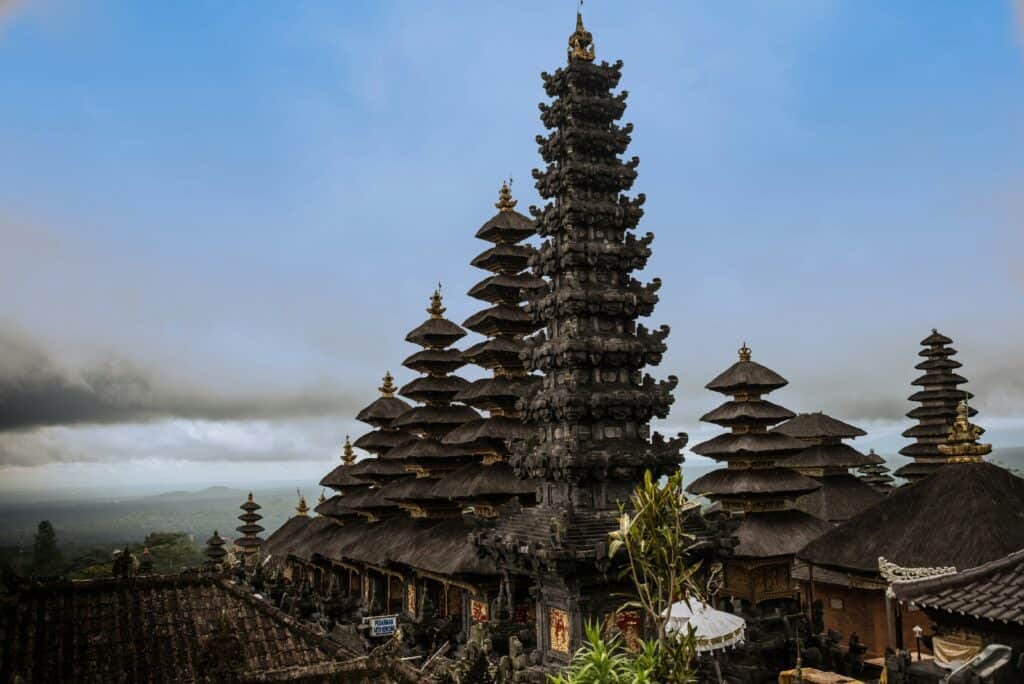
Another notable fact about Besakih Temple is its grand ceremony, which occurs annually in March or April during the appearance of the 10th full moon. Lasting for 21 days, this ceremony includes round-the-clock prayers spanning 24 hours each day.
The temple complex consists of over 80 individual temples, each dedicated to a different deity. The main temple, Pura Penataran Agung, is situated at the highest point of the complex and offers breathtaking views of the surrounding landscape. The architecture of Besakih is a blend of ancient Balinese and Hindu influences, with towering pagodas, intricately carved stone gates, and beautiful shrines.
Besakih plays a vital role in Balinese Hinduism as it is believed to be the spiritual center of the island. It is also a place where important ceremonies and rituals are held, including Galungan and Kuningan, which celebrate the victory of good over evil.
Uluwatu Temple
Perched on a cliffside overlooking the Indian Ocean, Uluwatu Temple is not only a place of worship but also a popular tourist attraction. The temple offers stunning panoramic views of the ocean and is particularly famous for its sunset Kecak dance performances.
Uluwatu Temple is dedicated to Sang Hyang Widhi Wasa, the supreme god in Balinese Hinduism. The temple’s location is believed to be a spiritual gateway between heaven and earth. The temple is also home to a large population of monkeys, which are considered sacred and are believed to protect the temple from evil spirits.
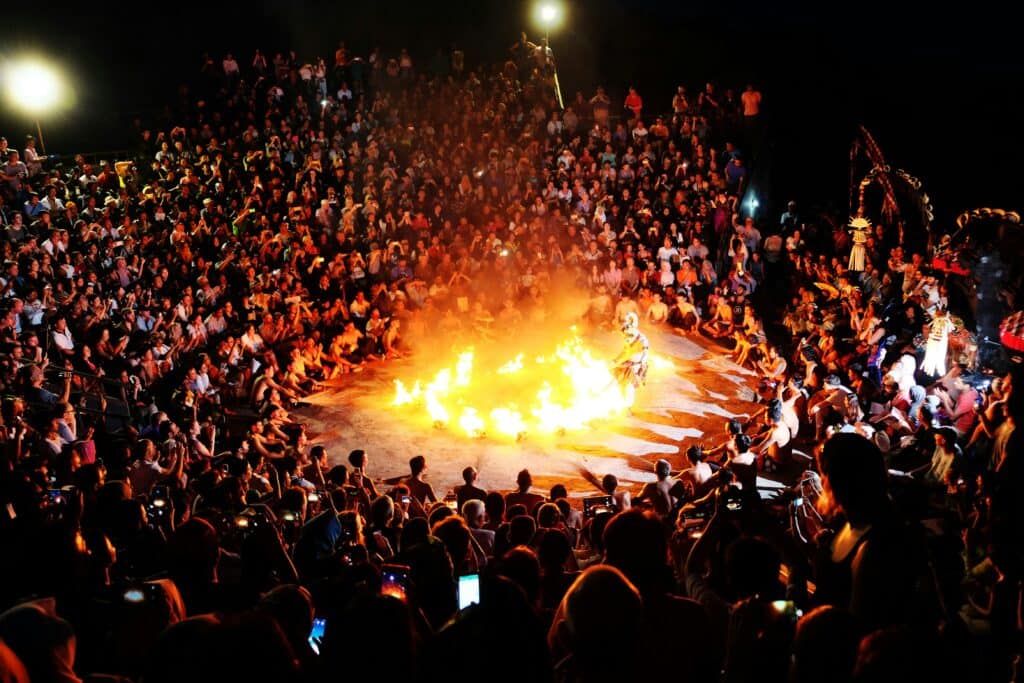
Uluwatu Temple’s history dates back to ancient times. Inscriptions suggest it was initiated by Mpu Kuturan, a Majapahit monk known for founding several significant temples in Bali. Expanded in the 11th century by Javanese sage Empu Kuturan, it was further developed by Dang Hyang Nirartha. Balinese Hindus revere it as a place where the powers of the Hindu Trinity converge, particularly worshipping Siva Rudra, the deity symbolizing all aspects of life in the universe.
The temple is open from 8:00 AM to 7:00 PM, with the captivating Kecak dance show held daily at 6:00 PM. The ideal time to visit is just before sunset. While a guide isn’t essential, they can enhance your experience. Avoid wearing loose jewelry or valuables. Plan for a visit lasting 1-2 hours. Entrance fees are Rp 30,000 for adults and Rp 15,000 for children per person.
When visiting Uluwatu Temple, it is important to be cautious of the monkeys, as they can be mischievous and may try to steal personal belongings. It is also advisable to wear appropriate clothing and follow the temple’s rules and regulations.
Goa Gajah
Goa Gajah, also known as the Elephant Cave Temple, is an ancient archaeological site located in Bedulu village. The temple dates back to the 9th century and is believed to have been built as a sanctuary for meditation and spiritual practices.
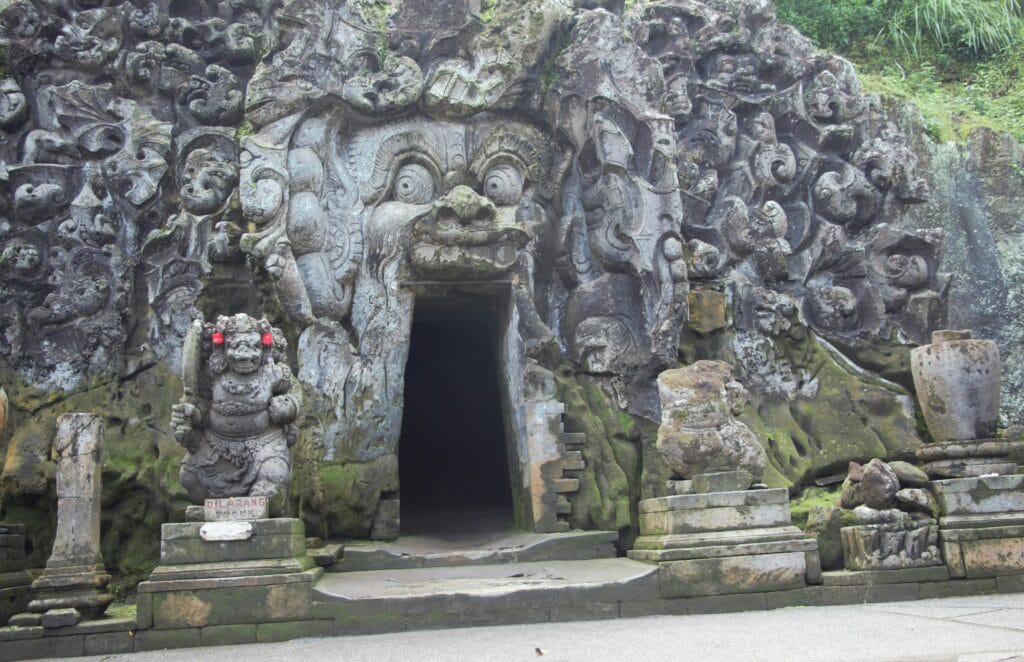
Despite its name, “Goa Gajah” or “Elephant Cave,” lacking actual elephants on site, has sparked various interpretations. Some suggest it originated from “Lwa Gajah,” the former name of the Petanu River. Others point to the Hindu God Ganesh, portrayed as an elephant. Setting aside the name, the site’s well-preserved Buddhist and Hindu imagery suggests an 11th-century origin, likely part of the “Bali Kingdom.” While the Bali Kingdom didn’t govern the entire island, it held sway over regions such as Ubud.
The main attraction of Goa Gajah is its cave entrance, which resembles an elephant’s head. Inside the cave, there are stone carvings of Hindu gods and a bathing pool with water flowing from the mouth of a stone statue. The site also features beautiful gardens and a peaceful atmosphere, making it a popular destination for tourists seeking tranquility.
Renowned for its imposing giant face and intricate smaller carvings, this temple is believed to offer protection against malevolent spirits, ensuring the area’s safety. Though some speculate the main figure might have represented an elephant, there’s no conclusive evidence supporting this theory. What is certain is its mention in the 1365 Javanese poem Desawarnana.
Accessing the cave complex entails descending a lengthy flight of stairs, posing challenges for wheelchair users due to the absence of alternative access. Inside, you’ll encounter Hindu incense baskets and the lingering scent of burning incense. Goa Gajah is also home to six statues, symbolizing the seven holy rivers of India, with one destroyed by an earthquake.
To explore the ancient carvings dating back to the 9th century at The Elephant Cave Temple, visitors are required to pay the Goa Gajah temple entrance fee. The fee structure for international travelers is as follows:
- Foreign Adult: Rp 50,000 per person
- Foreign Child: Rp 25,000 per person
Additionally, car parking is available at Rp 5,000 per car, and motorcycle parking is available at Rp 2,000 per motorcycle.
When visiting Goa Gajah, it is important to dress modestly and cover your shoulders and knees. Sarongs are available for rent at the entrance for those who need them. It is also advisable to bring insect repellent, as the area is surrounded by lush vegetation.
Pura Ulun Danu Bratan
Located on the shores of Lake Bratan in the mountains of Bedugul, Pura Ulun Danu Bratan is one of Bali’s most picturesque temples. It’s about 1,500 meters above sea level, so the weather is nice and cool up there. The lake is super clear and calm, except for when a gentle breeze comes along and makes little ripples on its surface.
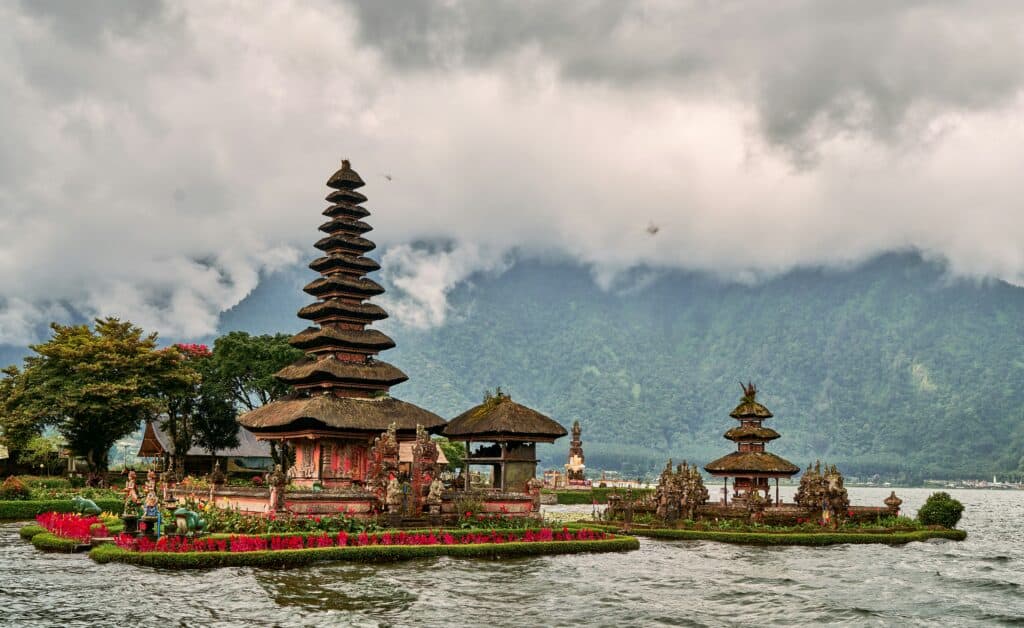
Pura Ulun Danu honors the Goddess Danu, who is revered as the queen of water, lakes, and rivers in Balinese culture. The temple comprises four sacred structures. Linga Pura, rising three levels high, is dedicated to the god Shiva. Pura Puncak Mangu, towering 11 levels, pays homage to Vishnu. Pura Teratai Bang serves as the primary temple, while Pura Dalem Purwa is dedicated to Sang Hyang Widhi and is a site for prayers seeking fertility, prosperity, and well-being.
The temple’s architecture reflects the Trimurti belief, with three sacred colors representing the gods: red for Brahma, the Creator; black for Vishnu, the Preserver; and white for Shiva, the Destroyer. Fun fact, the Pura Ulun Danu Beratan is actually showcased on the Indonesian 50,000 Rupiah banknote!
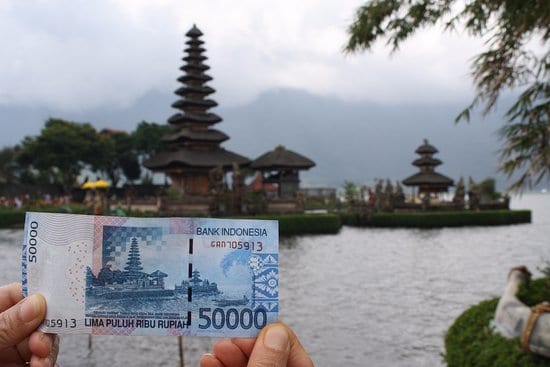
The temple complex consists of several shrines and pagodas surrounded by beautifully manicured gardens. The main temple is situated on a small island in the middle of the lake, creating a stunning reflection on the calm waters. The serene atmosphere and breathtaking scenery make Pura Ulun Danu Bratan a popular destination for both locals and tourists.
The best time to visit Pura Ulun Danu Bratan is during the dry season, from April to October, when the weather is clear and the lake’s water level is high. It is advisable to arrive early in the morning to avoid crowds and to take advantage of the calm and peaceful atmosphere.
Taman Ayun Temple
Taman Ayun Temple, located in Mengwi village, is a royal temple built by the Mengwi dynasty in the 17th century. The temple complex is surrounded by a moat and features beautiful gardens, lotus ponds, and intricately carved stone gates.

Founded in 1634 under the patronage of the Mengwi Dynasty, Taman Ayun Temple held significant importance as the main temple for the kingdom. Its name, “Beautiful Garden,” aptly mirrors the exquisite fusion of magnificent architecture and meticulously crafted gardens, symbolizing the profound spiritual ties of the Mengwi royals.
Taman Ayun Temple is dedicated to the ancestors of the Mengwi royal family and serves as a place of worship and cultural heritage. The temple’s architecture reflects traditional Balinese design, with multi-tiered roofs, ornate carvings, and symbolic statues. Also Taman Ayun Temple, a historical site in Bali, earned UNESCO World Cultural Heritage status in 2012 as part of Bali’s Subak cultural landscape.
When visiting Taman Ayun Temple, it is important to dress respectfully and follow the temple’s rules and regulations. It is also advisable to explore the surrounding gardens and take a leisurely stroll around the temple complex to fully appreciate its beauty.
Pura Luhur Batukaru

Batukaru Temple, situated on Mount Batukaru’s slopes in western Bali, Indonesia, is a popular Hindu temple. Locals know it as Pura Luhur Batukaru, one of the island’s nine directional temples, called Khayangan Jagat, believed to safeguard Bali and its people from malevolent spirits.
Perched on the southern slope of Mount Batukaru at approximately 1300 meters above sea level, the temple is surrounded by lush natural forests, offering a delightful stop for nature enthusiasts.
Pura Luhur Batukaru, nestled on Mount Batukaru’s slopes, is one of Bali’s most secluded temples. Dedicated to Mahadeva, the deity of Mount Batukaru, it holds significance as one of Bali’s six holiest temples.
Getting to Batukaru Temple, or Pura Luhur Batukaru, can be a bit tricky since there’s no public transportation available. Your best options are either to drive yourself or join an organized Bali tour.
When it comes to entrance fees, there’s actually no fee required to enter Batukaru Temple, but it’s customary to make a donation, especially for foreign visitors. This donation is often collected through sarong rentals and usually amounts to no more than 20,000 IDR or around USD$2. However, there have been a few cases of overcharging, so if you’re unsure about the current prices, it’s a good idea to ask your guide for assistance.
Pura Gunung Kawi Sebatu
Gunung Kawi Sebatu Temple, locally known as Pura Tirta Dawa Gunung Kawi Sebatu, is a hidden gem in Central Bali. Despite being one of the least visited temple complexes on the island, it boasts remarkable beauty and tranquility. Set amidst lush gardens and ponds teeming with carp and lotus flowers, the temple offers a serene escape.

The complex comprises ancient shrines surrounded by mountain spring-fed water features. In a separate area, there are bathing pools and fountains where locals come for purification rituals. Situated in the highland village of Sebatu, Tegallalang, Gianyar, about 12 km northeast of Ubud central, the temple is a peaceful retreat.
Meanwhile, Pura Gunung Kawi in Tampaksiring is renowned for its rock-cut shrines, believed to be tombs of Balinese royalty from the 11th century. Legend has it that the temple was created by the god Indra as a sanctuary for meditation and spiritual reflection. The complex features ten towering shrines, picturesque rice terraces, and a tranquil river flowing through the valley.
Pura Lempuyang
Pura Lempuyang Luhur, one of the oldest and most respected temples you’ll find in Bali, Indonesia. Pura Lempuyang is located on the eastern slopes of Mount Lempuyang, in the Karangasem Regency of Bali. When you roll up, you can’t miss the grand entrance, known as “The Gate of Heaven”. It frames the mighty Mount Agung in the background, giving you a view that’s straight out of a postcard.

So, “Lempuyang” is a mash-up of two words: “lempu” (that’s like “light” or “ray”) and “hyang” (which means “God”). Basically, Pura Lempuyang means “The Radiant Temple of God”. It’s in the eastern part of Bali, so it’s where the sun comes up. The temple complex isn’t just one building; it’s spread out along a hiking trail that takes you to the summit. The main deal is Pura Lempuyang Luhur, sitting at a cool 1,175 meters (that’s about 3,855 feet) above sea level right on top of Mount Lempuyang.
Pro Tip: Don't believe anything you see on Instagram about Pura Lempuyang.
According to the old stories, a big shot called Sang Hyang Parameswara brought mountains from India to Bali back in the day. Mount Batur, Mount Rinjani, and the king of the bunch, Mount Agung, were all part of the deal. Pura Lempuyang is a big deal in Balinese Hinduism. It’s got three sections—Lempuyang Sor, Lempuyang Madya, and Lempuyang Luhur—that folks use for prayers and stuff.
Summary
Bali’s temple culture reflects the island’s long history and strong spiritual beliefs. Each temple holds its own significance, giving visitors a window into Balinese Hinduism and its cultural roots. Exploring these temples offers insight into Bali’s traditions and customs.
Respect and reverence are key when visiting temples. Follow their rules, dress modestly, covering your shoulders and knees, and behave respectfully. Remember, these sites aren’t just tourist spots but sacred places of worship for locals.
In summary, touring Bali’s temples is a profound journey, connecting visitors with the island’s spirituality and culture. Whether you’re observing a purification ritual at Pura Tirta Empul or catching a sunset Kecak dance at Uluwatu Temple, each visit offers a unique and memorable experience. Don’t miss out on exploring these temples during your Bali trip.
FAQ
Some of the famous temples in Bali are Tanah Lot Temple, Uluwatu Temple, Besakih Temple, Tirta Empul Temple, and Ulun Danu Beratan Temple.
A general rule on what to wear to enter temples in Bali is for both men and women are advised to wear tops that cover their shoulders and upper arms. It’s also customary to cover legs with a sarong or temple scarf.
Temples are typically open to both locals and tourists, but inside the temples there are some specific area where only the Priest can enter.

